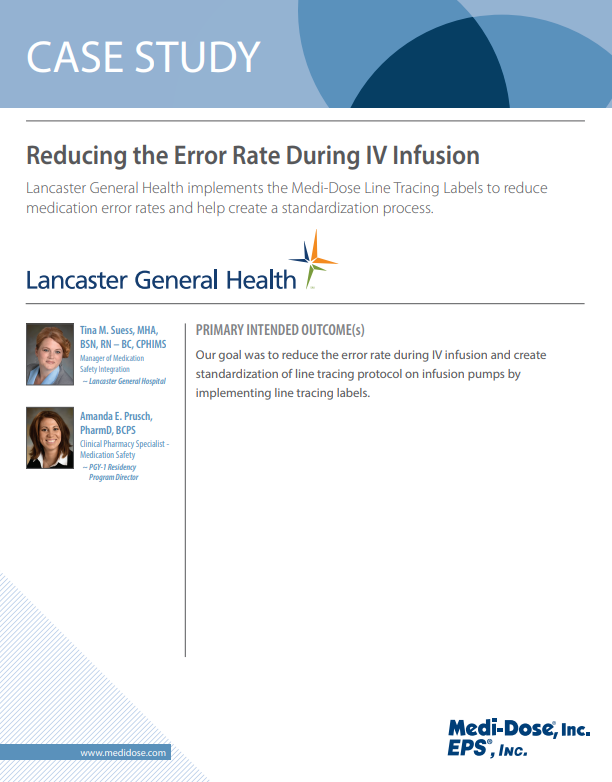
Lancaster General Health implements the Medi-Dose Line Tracing Labels to reduce medication error rates and help create a standardization process.
Our goal was to reduce the error rate during IV infusion and create standardization of line tracing protocol on infusion pumps by implementing line tracing labels.
As one of the first hospitals in the nation to integrate their smart pumps with EHR (Epic), Lancaster General Hospital was using stickers, masking tape, and other variations to handwrite and label IV lines and infusion pumps. Using more than 900 pumps (2-6 channels/ pump), this caused confusion, creating the need for LGH to reduce their error rate when pushing and switching lines.
“Line trace itself is never something that technology is going to be able to do,” says Tina Suess, Manager of Medication Safety for Lancaster General Hospital. “The technology cannot make sure that the tubing is placed through the correct cassette or channel in the pump.”
We determined that the Medi-Dose Line Tracing Labels would create ease-of-use for nurses tracing lines on our high-risk medications:

“The line trace labels actually help us draw attention to an area in the process where technology can exist, but we still need the human to do the right thing which is follow the tubing from the bag through the pump to the patient,” Suess says.
After identifying a number of errors within their internal error report, Lancaster General Hospital realized with proper line trace, errors could be prevented.
We established a line trace process, which began with the question, “how are we going to label the line?” Lancaster General Hospital consulted Medi-Dose, where the two helped establish a label standard concept.
At LGH, line trace needs to be done a minimum of every eight hours. Protocol dictates after the nurse hangs the bag in the patient room, the label is placed on the bag, at the top of the line, as well as the distal end of the line. The nurse’s hand should not leave the line during the trace process, which allows for rapid identification of the correct line. Medi-Dose Line Tracing Labels are flexible, offering color-coded or pre-printed customized options. Effectively, the risk of misreading a label due to penmanship is eliminated.
Implementation of Medi-Dose 3-Part Piggy-Back Line Tracing Labels offer three important benefits, including: facilitation of easy line trace, improved accuracy and minimization of IV line confusion.
In addition to the pre-printed High Alert Line Tracing Labels, Medi-Dose offers Customizable Line Tracing Labels with its MILT software, allowing for such customization as:
• Bar Codes
• Graphics
• Special Fonts
• Colors
• Tall-Man Lettering (TML)
• Shapes and/or Logos
• Symbols and/or Pictures
“We can say that when we have taken that deep dive and really looked at all of our errors related to heparin and adopted a couple different things, one was a line tracing process and these [Medi-Dose line tracing] labels, overall our error rate definitely decreased,” said Amanda Prusch, Clinical Pharmacy Specialist - Medication Safety for Lancaster General Hospital. Prusch continues, “after putting in several technologies, mostly manual-type processes, the [Medi-Dose Line Tracing Labels] were part of the overall rate in dropping that number.
Medi-Dose Line Tracing Labels is the tool that allowed Lancaster General Hospital to standardize their line labeling process, according to Suess. While looking to drive consistent workflow, the line label facilitates an easy-to-use fashion for the nurse.
“We’re very interdisciplinary here. The pharmacist facilitates those labels for nursing. The nurse doesn’t have to go run someplace else to get the labels. So our approach that the product actually gets dispensed with the bag when the nurse pulls it from Pyxis, is actually saving the nurse a few footsteps and we always appreciate that,” said Suess.
Pharmacist oversight is now protocol for adjustments made by the nurse, including pharmacy validation and confirmation.
“Line trace is something technology will never be able to do. Technology can’t make sure
tubing is placed through the correct channel of a pump. [Medi-Dose] Line Tracing Labels
helped us draw attention to area where technology exists but we still need humans to
practice following the line from pump to bag to human,” Suess said.